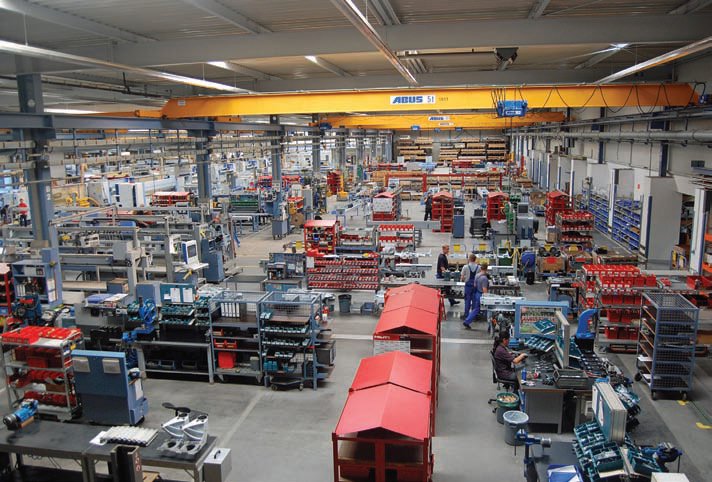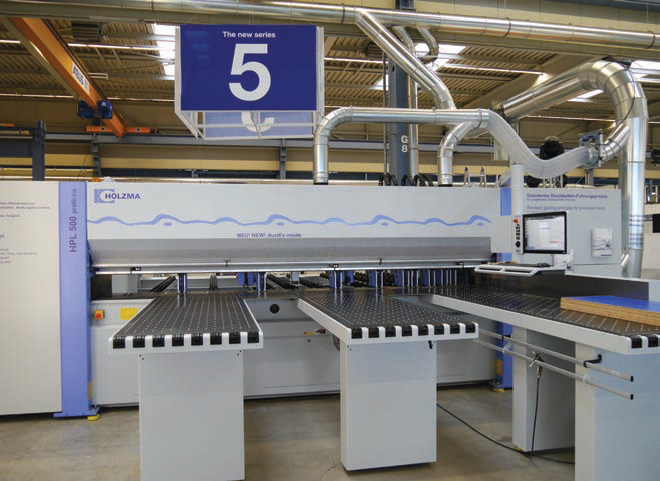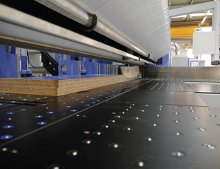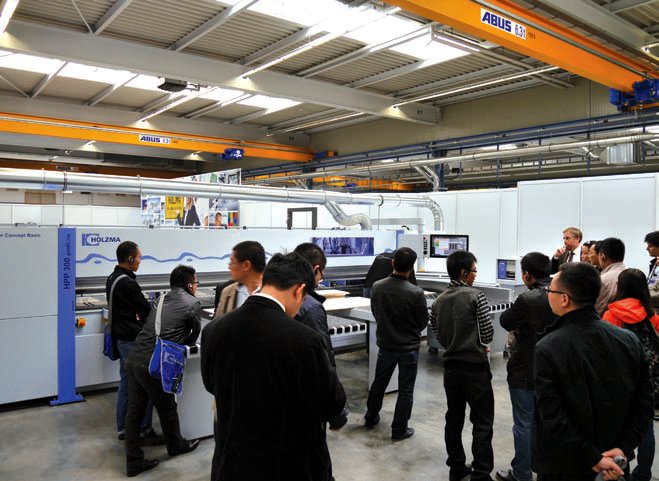The sawn supremacy
16 December 2014German panel sawing technology specialist Holzma has been developing new technologies to boost sawing efficiencies. Stephen Powney stopped off at its headquarters during WBPI’s Focus on Germany tour.
It's been a busy season for German panel sawing technology specialist Holzma, based in Holzbronn, Baden-Württemberg. When WBPI visited Holzma in early October, it had just welcomed around 2,200 visitors to its Treff - an important annual in-house event showcasing technological developments for customers. Other Homag Group machinery, including Brandt, Bütfering, Weeke and Ligmatech was also demonstrated.
Holzma, whose saw portfolio ranges from single saws for the carpentry sector to large industrial systems with a panel throughput of more than 100m3 per hour, has also enjoyed a successful first six months of 2014.
Holger Bomm, Holzma managing director, reported a "substantial" rise in first half sales and profits due to favourable economic conditions and a global rise in demand for Holzma's products.
A successful Holz-Handwerk fair in March proved a clear indication of this positive trend.
"Our products were very well received by trade visitors and we were able to fill our order books for the months ahead right at the beginning of the year," said Mr Bomm.
This follows a 2013 financial year where turnover significantly increased against the previous year.
"In 2013, we achieved a turnover of almost €80m from sales of nearly 900 saws worldwide and our steadily growing array of services offerings," said Mr Bomm.
Current sales levels make the company hopeful that it could break the 1,000-machinessold barrier in 2014.
Germany, Austria and Switzerland play a very central role in Holzma's sales, with China nearly at the same level.
Other strong regions are eastern Europe (particularly Poland) and South America (especially Brazil), while Turkey is also an active buyer of machinery. In terms of large industrial systems, Italy is one of the best customers.
"In the US we notice a steady improvement in the situation, which we are very pleased with," said Mr Bomm.
Holzma's machines are not all made in the 30,000m2 German factory. It also has a 5,000m2 factory in Spain producing two models in the 2 series, while a Shanghai facility - Homag Machinery Shanghai - manufactures the HPP 180 for the Chinese, Asian and Indian markets.
A more recent expansion saw Holzma effectively expanding to Sâo Paulo, Brazil, where parent company Homag Machinery Sâo Paulo is building the HPP 120 and HPM 120 for the South American markets.
Holzma, which has 420 staff at the Holzbronn main facility and an apprentice workforce ratio of 11%, is also planning a €5m factory investment over the next two and a half years.
For the Treff, Holzma's motto "We set the trends" was emblazoned across the event and highlights included the company's new 5 series, the HPP 300 multiTec for sawing, drilling and routing, Holzma's new de-stacking concept and the combiTec.
"This year we had a lot of news," said Holzma marketing manager Kim Esser. "The main new launch is the new 5 series."
The relaunch of the 5 series - Holzma's high performance range with a cutting length of up to 6.5m - follows the streamlining of the 3 and 4 series. This means a reduction in the number of saw models and instead a greater choice and flexibility in terms of equipping the machine.
The streamlined range includes the HPP 500, the HPL 500 (with heavy-duty lift table for automatic feeding) and the HKL 500 angular saw unit featuring automatic rip- and cross-cutting for high volume output in industrial applications.
Holzma says changes include significantly improved ease of servicing and maintenance, extraction system design improvements, a re-design of the saw carriage to include making belt changing an easy task, further improvements to chip guidance features and an update to the lifting principles of saw blade motors.
The extension of dustEx to the 5 series is a key improvement.
"Customer requirements have increased considerably in recent years," said Martin Kress, Holzma product manager.
"In addition to emission protection, it is also the simple question of efficiency. If less dust is produced during cutting, this reduces the time and costs involved in unproductive jobs such as cleaning the machines and the parts that have been cut.
"This is particularly important in industry, where our 5 series saws are mainly used. Here, giant books of panels are cut around the clock, seven days a week.
"This inevitably causes a lot of dust. If it fi nds its way into the switch cabinets, for example, this dust could cripple the electronics.
"Expensive production downtime caused by machine stoppages would be the consequence.
"In the light of increasingly interlinked systems in industry, dust extraction is an extremely important issue for our customers; and is gaining in signifi cance."
dustEx works by special air jets on the machine table guiding the dust to the right hand side of the machine, thereby capturing dust not only via the saw carriage and the pressure beam, but also at the right-angled fence where signifi cant dust accumulates.
The addition of dust-trap curtains on both sides of the pressure beam seal off the cutting area and create a dust fl ow channel, while improved suction geometry at the right-angled fence is designed to pick up more dust and chips.
Holzma says the machine table is kept clean, even after dust cuts.
Saws now also automatically check whether the switch cabinet door is closed before starting, to prevent dust damaging electronics.
Another potential problem area - stoppages caused by small trimmings falling into the cutting gap, has also been tackled. Trimmings are not such a problem when they are bigger, but the recent trend towards cutting pattern optimisation to save on raw materials has meant smaller and smaller off-cuts, which can potentially cause a blockage.
Holzma changed the design of the saw carriage so that these parts can no longer damage it or the energy chain.
Other changes are designed to make it possible to replace wear parts quickly - such as a modifi ed design to simplify the task of changing belts. And in the case of the new 5 series, all the lubrication points of the saw carriage are now located in one central position and are easily accessible.
Further changes to reduce maintenance include an update to the pressure beam guiding system, which is no longer effected by cylinders, but by means of THK guides. Vibration-resistant composite material SORB TECH continues to be used for the machine body.
Another demonstration during the Treff was Holzma's de-stacking concept. This concept, fi rst presented at the 2013 Ligna exhibition, is an example of Homag's domino philosophy - looking at production processes rather than just a single machine, with the aim of giving customers more effi cient manufacturing operations.
This ties in with Holzma's "More than just sawing" motto.
Holzma has taken videos at customers' facilities to identify ineffi ciencies and bottlenecks in the manual stacking process and used this information as a basic analysis for creating the new de-stacking concept.
Its de-stacking solution includes software, a label printer, a parts buffer, waste container, feeding and de-stacking aids and a new scissorlift pallet truck.
Labels, with information to show stacking staff which pallet to stack and a diagram of how the panels should be stacked, are automatically attached to panels.
This ergonomic approach, Holzma says, leads to the formation of stable stacks, higher stacks, a reduction in human error and a reduced number of stacks.
It says trials have shown a 30% reduction in the number of stacking stations necessary.
"Domino philosophy will become more and more important," said Ms Esser.
Another new machine turning heads at the Treff was the HPP 300 multiTec. Designed for the production of facades and partition walls, the machine can complete three processing steps - sawing, drilling and routing - in a single pass.
Holzma says the technology produces readyto- assemble elements and avoids lengthy and error-prone drilling on the building site, therefore speeding up installation and boosting accuracy.
Other recent developments include offering a special re-cuts option for industrial batch size 1 manufacturing. The combiTec is available for the angular systems HKL 300 profi Line and HKL 400 profi Line and completes most re-cuts in a fully automated process, saving time and money because it reduces the amount of material used and the volume of waste produced.



